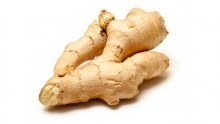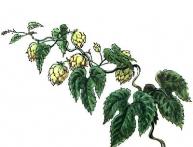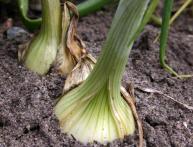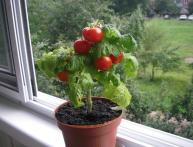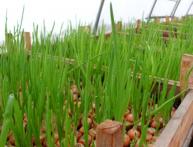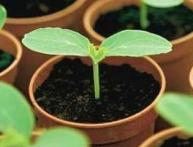How to grow ginger in the garden: germination, replanting, harvesting

In the retail chain you can buy ground and pickled ginger, which is widely used in home cooking and folk medicine.
Fresh ginger root (rhizome) is also available for sale. The powerful roots, consisting of separate segments, involuntarily lead one to wonder whether they can be planted in an open-air area or whether a native of Asia will not take root in a temperate climate?
Let's try to figure out how to grow ginger in the garden and what kind of harvest is worth expecting.
Content:
- Brief description of the ginger plant
- How to germinate ginger before planting in the garden
- Transplanting young ginger into the garden
Brief description of the ginger plant
Ginger roots were brought to European countries by merchants from China or other Asian countries back in the Middle Ages. Thick, curved, in a cork shell, they were valued in the pharmaceutical production of various drugs and in the culinary industry. Thick, curved, underground roots consisting of well-separable segments were called ginger root. shoots - rhizomes of the perennial herbaceous plant ginger (common ginger).
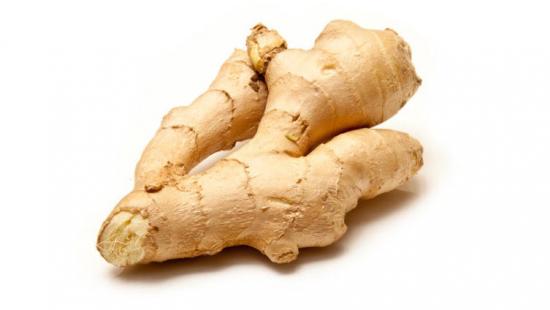
This plant belongs to the genus Ginger, family Zingiberaceae. Pharmaceutical ginger has a developed underground part - a rhizome, from which fibrous roots and erect green shoots extend. Rhizomes grow horizontally under the soil layer at almost the same depth.
They consist of an upper protective cork layer and internal parenchyma.The parenchyma of the ginger rhizome contains not only vascular-fibrous bundles, but also cells with essential oil.
On a straight, round stem, elongated narrow simple leaves are alternately located, which at the beginning of growth are curled into a dense tube. Externally, the stems with leaves resemble sedge.
The plant produces an arrow-shaped peduncle, at the top of which there are flowers collected in spike-shaped inflorescences resembling bump. The calyx of the flowers consists of five fused green sepals. There are three petals and they are either purple or orange with purple edges. In place of flowers, fruits - boxes - are formed.
From its interesting powerful rhizome to unusual, quite bright flowers, ginger looks quite interesting, so many lovers of exotic plants have a desire to grow it on their site.
How to germinate ginger before planting in the garden
Planting material for self-growing ginger in open ground conditions is most often parts of the rhizome on which there are living buds. You can buy them at any grocery store, where they come from Asian countries.
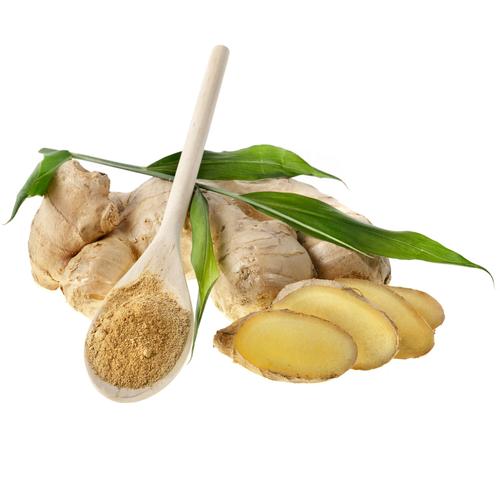
When choosing planting material for the garden, you should give preference to the rhizome that has:
- smooth surface
- elastic top layer
- cover plug without rot
- clearly visible buds - eyes
- inner layer without signs of drying
Since under natural conditions ginger grows in a fairly warm climate, the short summer in regions with a temperate climate is not enough for the plant to develop normally. Based on this, it is necessary to germinate the rhizomes in advance before boarding. It is better to start this in February-March.
Before planting, divide the rhizome into separate fragments of two or three segments - phalanges. Soak the ginger pieces in warm water for a day.
Place a drainage layer on the bottom of a wide pot and fill it 2/3 with a mixture of turf soil, sand and humus.
Place the rhizome pieces with their eyes facing up and cover them with a 2 cm thick layer of soil. Water everything well. The soil in the pot should be constantly moist. After 15-20 days, green cones of germinating ginger will appear above the surface of the earth.
During further cultivation, it is important to maintain the humidity regime and not allow even short-term drying out. soil. The room temperature should be +20 +22 degrees. Every two weeks, feed the plant with complex mineral fertilizers.
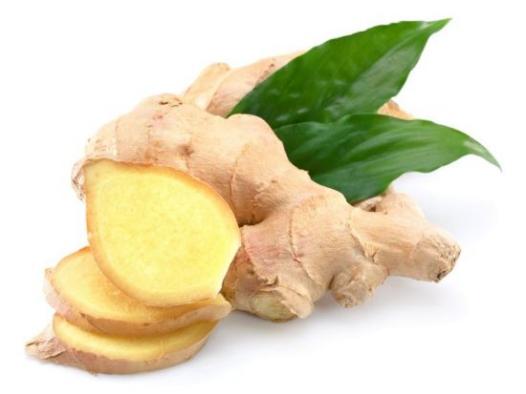
Keep the pot of sprouted ginger in a well-lit window, but keep it away from direct sun. The leaves that appear can be regularly sprayed with settled water. At the end of spring, ginger needs to be transplanted into open ground.
Transplanting young ginger into the garden
A well-lit area with sufficiently moist soil is suitable for growing ginger in the garden. The soil needs to be loose, filled with sand and organic matter. A shallow trench is made in it, in which potted ginger seedlings are placed at a distance of 10-15 cm from each other.
Caring for the plant comes down to the following:
- watering
- loosening the soil once a week
- weed removal
- feeding
- spraying in dry weather
If ginger was planted in February - March, then in mid-September you can begin harvesting. If the leaves turn yellow and the stems begin to fall apart, then it’s time to harvest. To do this, stop watering 10 days before, after which you can start digging up the rhizomes with a shovel.
Of course, you can’t count on too much growth, but still these will be full-fledged ginger rhizomes. After everything is dug up, the rhizomes are dried for three days and stored in the same conditions as other root crops.
To obtain flowers, you can conduct an experiment and plant several plants in a greenhouse. Perhaps the rhizomes will safely overwinter and germinate in the spring. If the experiment is successful, then in the third year the plant can please you with flowering. But if the plant is planted for flowers, then it is still better to grow it in pots, bringing it indoors for the winter.
Video about ginger at home:
Interesting information about the vegetable garden

